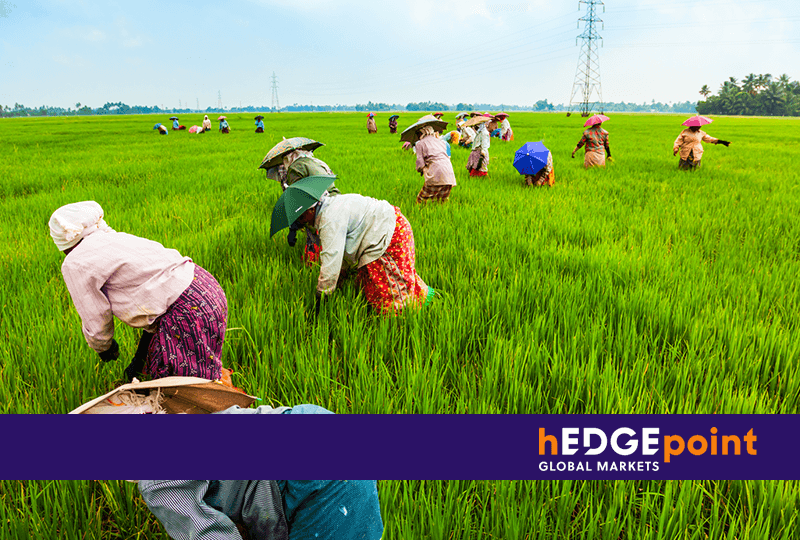
Currently, the weather in India is threatening the development of agricultural crops and supplies locally and globally. The El Niño weather pattern has arr

Currently, the weather in India is threatening the development of agricultural crops and supplies locally and globally. The El Niño weather pattern has arrived in the country and is causing extreme droughts.
Just to give you an idea: the Indian nation recorded its lowest level of rainfall in the last 100 years in the month of August. As a result, climatic adversity is increasing volatility for commodity market participants.
In this post, we’ve invited Lívea Coda, Market Intelligence Coordinator at hEDGEpoint, to explain:
Keep reading to check it out!
What’s the importance of India in commodity production?
India is the second largest sugar producer in the world, behind only Brazil. In addition, the country’s population is the largest consumer of this commodity on the entire planet. Thus, a large part of its production is destined for the domestic market.

“While Brazil consumes around 9 million tons, India consumes approximately 29 million tons,” Lívea Coda pointed out.
The Indian nation’s production capacity is similar to Brazil’s, but today there’s one specific highlight: the ethanol being produced from sugar cane. According to Coda, the Indians are evolving this technology to increase the ethanol blend each year to reduce their dependence on foreign oil.
“The country imports fossil fuels, a highly volatile market dependent on international geopolitics. The challenge is to reduce the need for energy commodities such as oil. To this end, growth in biofuel demand has been encouraged,” she explained.
Cotton and rice are other significant crops as India is the second largest producer of these commodities on the planet. The forecast is that 26 million tons of cotton will be produced in the next season, a total which is 4% above the previous harvest. Rice is forecast to yield 127 million tons for the 23/24 cycle. This data is courtesy of the United States Department of Agriculture (USDA).
El Niño occurs when temperatures in the central and eastern Pacific Ocean rise above normal. This warming trend brings changes in atmospheric patterns which cause a weakening in monsoon circulation over the Indian subcontinent.
In the last four years of El Niño, India has faced constant drought conditions, with rainfall 90% below average. In 2023, the phenomenon was confirmed again, and the monsoons were delayed. There was little rain between July and September, confirming a historic minimum in this period.
You can also read:
Furthermore, there will be critical elections in India next year, and inflation is currently above the rate that’s been targeted.
“Inflation stands at 6% per year, but the target is 4%. I’d like to highlight that food inflation is even higher as it’s reached 9.5%. The government wants this number to decrease, given the upcoming electoral scenario. Therefore, it intends to prioritize the internal market,” Coda clarified.
For you to better understand the logic, it’s vital to know that the Indian government controls sales to the domestic market, as well as imports and exports through quotas. If production is poor, the chances of issuing export quotas are reduced, which have effects on the total trade flow.
As you can see, India faces several factors that generate volatility. According to Coda, the period from June to September is crucial to assess whether the sugarcane was able to develop.
This year, the low rainfall in key states for sweetener production impacted development during this period. Supply, therefore, should be further reduced in a scenario where stocks are already low.
The abnormally dry weather is threatening the sugar supply, with the risk of even making the country’s exports unviable.
“In years of good production such as the 21/22 season, India managed to export a record 11 million tons of sugar. In the 22/23 harvest, adverse weather conditions reduced productivity. The surplus was smaller, with only six million tons of sugar being exported,” hEDGEpoint’s Market Intelligence Coordinator asserted.
Also read:
With the historic drought, the 23/24 sugar harvest was compromised, and production is estimated at 30 million tons. The surplus could therefore be only one million tons. This volume should be intended to increase the country’s currently low reserves. India’s target is at least three months of consumption, having ended the 22/23 harvest well below this level at four million tons.
The restriction on exports has already been priced in by the market. Meanwhile, the Indian government appears determined to increase the country’s reserves at any cost. Even with all the investment in the country’s alcohol sector, India seems determined to restrict ethanol production based on sugarcane juice and Type B molasses. These products contain a higher sucrose content which allow only the use of the lowest quality byproduct, Type C molasses.
In this way, achieving the desired target of mixing ethanol together with gasoline is at risk, slowing down the pace of its biofuel program by prioritizing the sweetener’s production.
“The effect of this measure will add around 2Mt of sugar to the country’s available supply, generating more comfortable stocks at the end of 23/24, and enabling India to return as an exporter in 24/25, if the weather cooperates,” Coda concluded.
Rice and cotton also suffer due to drought since they’re crops that depend on water to fully develop. 23/24 cotton production will likely fall 7.5% year-on-year. If this situation is confirmed, imports could more than double compared to 2022, according to local sources Reuters Mumbai and the Cotton Association of India (CAI).
Thailand is another important global producer in the sugar market. However, unfavorable weather has also hit that country. The export availability of the merchandise there fell from eight to five million tons in the following season.
Thai domestic consumption is only three million tons of sugar, normally guaranteeing a greater surplus when compared to India. With these two nations affected by adverse conditions, the first quarter of 2024 is expected to present deficits in relation to trade flows.
“This should happen from the moment the international market needs Indian and Thai sugar. Hence, the price may increase due to the supply reduction in the Northern Hemisphere,” added Coda.
In this sense, Brazil can assume a leading role as it expects a harvest of excellent sugar production, estimated to set a record in the 23/24 cycle. In this way, the country should account for a large part of global trade.
Imagine that you have a candy company, and you need sugar. With the weather causing serious consequences for production in India and Thailand, there may be changes in this key commodity’s price.
In this context, risk management becomes more essential for companies that depend on the specific commodity. Using hedging instruments, participants in this market are able to protect themselves against volatility.
hEDGEpoint exists to put together hedging products, market intelligence, and insights that closely follow movements in the agricultural and energy sectors. With a team of professionals who operate on five continents, we conduct analyses that contribute to solid decision-making.
Subscribe to the hEDGEpoint newsletter and you’ll stay tuned to all relevant events for participants in commodity markets.

Rua Funchal, 418, 18º andar - Vila Olímpia São Paulo, SP, Brasil
Contato
(00) 99999-8888 example@mail.com
Section
Home
O que Fazemos
Mercado
Quem Somos
HUB
Blog
Esta página foi preparada pela Hedgepoint Schweiz AG e suas afiliadas (“Hedgepoint”) exclusivamente para fins informativos e instrutivos, sem o objetivo de estabelecer obrigações ou compromissos com terceiros, nem de promover uma oferta ou solicitação de oferta de venda ou compra de quaisquer valores mobiliários, commodity interests ou produtos de investimento.
A Hedgepoint e suas associadas renunciam expressamente a qualquer uso das informações contidas neste documento que direta ou indiretamente resulte em danos ou prejuízos de qualquer natureza. As informações são obtidas de fontes que acreditamos serem confiáveis, mas não garantimos a atualidade ou precisão dessas informações.
O trading de commodity interests, como futuros, opções e swaps, envolve um risco substancial de perda e pode não ser adequado para todos os investidores. Você deve considerar cuidadosamente se esse tipo de negociação é adequado para você, levando em conta sua situação financeira. O desempenho passado não é necessariamente indicativo de resultados futuros. Os clientes devem confiar em seu próprio julgamento independente e/ou consultores antes de realizar qualquer transação.
A Hedgepoint não fornece consultoria jurídica, tributária ou contábil, sendo de sua responsabilidade buscar essas orientações separadamente.
A Hedgepoint Schweiz AG está organizada, constituída e existente sob as leis da Suíça, é afiliada à ARIF, a Associação Romande des Intermédiaires Financiers, que é uma Organização de Autorregulação autorizada pela FINMA. A Hedgepoint Commodities LLC está organizada, constituída e existente sob as leis dos Estados Unidos, sendo autorizada e regulada pela Commodity Futures Trading Commission (CFTC) e é membro da National Futures Association (NFA), atuando como Introducing Broker e Commodity Trading Advisor. A Hedgepoint Global Markets Limited é regulada pela Dubai Financial Services Authority. O conteúdo é direcionado a Clientes Profissionais e não a Clientes de Varejo. A Hedgepoint Global Markets PTE. Ltd está organizada, constituída e existente sob as leis de Singapura, isenta de obter uma licença de serviços financeiros conforme o Segundo Anexo do Securities and Futures (Licensing and Conduct of Business) Act, pela Monetary Authority of Singapore (MAS). A Hedgepoint Global Markets DTVM Ltda. é autorizada e regulada no Brasil pelo Banco Central do Brasil (BCB) e pela Comissão de Valores Mobiliários (CVM). A Hedgepoint Serviços Ltda. está organizada, constituída e existente sob as leis do Brasil. A Hedgepoint Global Markets S.A. está organizada, constituída e existente sob as leis do Uruguai.
Em caso de dúvidas não resolvidas no primeiro contato com o atendimento ao cliente (client.services@hedgepointglobal.com), entre em contato com o canal de ouvidoria interna (ombudsman@hedgepointglobal.com – global ou ouvidoria@hedgepointglobal.com – apenas Brasil) ou ligue para 0800-8788408 (apenas Brasil).
Integridade, ética e transparência são valores que guiam nossa cultura. Para fortalecer ainda mais nossas práticas, a Hedgepoint possui um canal de denúncias para colaboradores e terceiros via e-mail ethicline@hedgepointglobal.com ou pelo formulário Ethic Line – Hedgepoint Global Markets.
Nota de segurança: Todos os contatos com clientes e parceiros são realizados exclusivamente por meio do nosso domínio @hedgepointglobal.com. Não aceite informações, boletos, extratos ou solicitações de outros domínios e preste atenção especial a variações em letras ou grafias, pois podem indicar uma situação fraudulenta.
“Hedgepoint” e o logotipo “Hedgepoint” são marcas de uso exclusivo da Hedgepoint e/ou de suas afiliadas. O uso ou reprodução é proibido, a menos que expressamente autorizado pela HedgePoint.
Além disso, o uso de outras marcas neste documento foi autorizado apenas para fins de identificação. Isso, portanto, não implica quaisquer direitos da HedgePoint sobre essas marcas ou implica endosso, associação ou aprovação pelos proprietários dessas marcas com a Hedgepoint ou suas afiliadas.
aA Hedgepoint Global Markets é correspondente cambial do Ebury Banco de Câmbio, de acordo com a resolução CMN Nº 4.935, DE 29 DE JULHO DE 2021, Artigo 14 do Banco Central do Brasil (BACEN).
Para mais informações sobre nosso parceiro, serviços disponíveis, atendimento e ouvidoria, acesse o link a seguir: https://br.ebury.com/